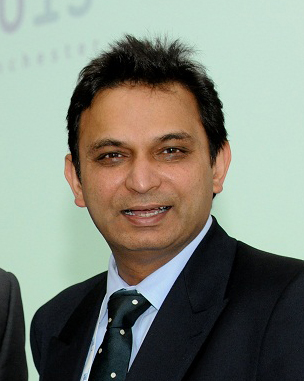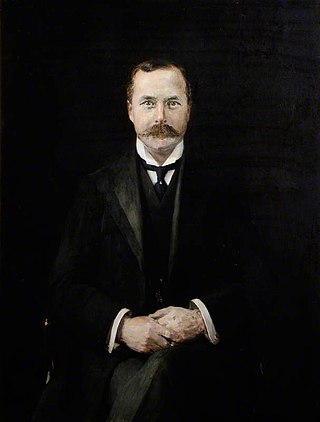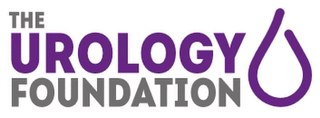
A nephrectomy is the surgical removal of a kidney, performed to treat a number of kidney diseases including kidney cancer. It is also done to remove a normal healthy kidney from a living or deceased donor, which is part of a kidney transplant procedure.
Edwin Hurry Fenwick (1856–1944), British urologist, early adopter of cystoscopic and x-ray technologies. It was largely through the efforts of Fenwick that urology was shaped into a specialty in Great Britain, recognized by the Royal Society of Medicine.
Douglas S. Scherr, M.D. is an American surgeon and specialist in Urologic Oncology. He is currently the Clinical Director of Urologic Oncology at Weill Cornell Medicine. He also holds an appointment at the Rockefeller University as a Visiting Associate Physician. Scherr was the first physician at Cornell to perform a robotic prostatectomy as well as a robotic cystectomy.

Richard Trevor Turner-Warwick was a British urologist who was internationally known for his work on the surgical restoration of the structure and function of the genitourinary tract. He introduced video-cysto-urethrography.

Roger Sinclair Kirby FRCS(Urol), FEBU is a British retired prostate surgeon and professor of urology, researcher, writer on men's health and prostate disease, founding editor of the journal Prostate Cancer and Prostatic Diseases and Trends in Urology and Men's Health and a fundraiser for prostate disease charities, best known for his use of the da Vinci surgical robot for laparoscopic prostatectomy in the treatment of prostate cancer. He is a co-founder and president of the charity The Urology Foundation (TUF), vice-president of the charity Prostate Cancer UK, trustee of the King Edward VII's Hospital and as of 2020 is president of the Royal Society of Medicine (RSM), London.

Sir David Innes Williams was a British paediatric urologist.
Reed Miller Nesbit was an American urologist, surgeon, and professor. He was Head of the Urology Section of the Department of Surgery at the University of Michigan Medical School in Ann Arbor, Michigan, from 1930–1967. Nesbit was a pioneer of transurethral resection of the prostate. He devised the Nesbit operation for treating Peyronie's disease, and he made prominent contributions to pediatric urology, most notably the Cabot-Nesbit style orchiopexy.

Prokar Dasgupta is an Indian-born British surgeon and academic who is professor of surgery at the surgical academy at King's Health Partners, London, UK. Since 2002, he has been consultant urologist to Guy's Hospital, and in 2009 became the first professor of robotic surgery and urology at King's, and subsequently the chairman of the King's College-Vattikuti Institute of Robotic Surgery.

John M. Fitzpatrick was an Irish urologist, emeritus professor of surgery at the University College Dublin School of Medicine & Medical Science and Head of Research at the Irish Cancer Society.

Terence John MillinFRCSI FRCS LRCP was a British-born Irish urological surgeon, who in 1945, introduced a surgical treatment of benign large prostates using the retropubic prostatectomy, later known as the Millin's prostatectomy, where he approached the prostate from behind the pubic bone and through the prostatic capsule, removing the prostate through the retropubic space and hence avoided cutting into the bladder. It superseded the technique of transvesical prostatectomy used by Peter Freyer, where the prostate was removed through the bladder.
The British Association of Urological Surgeons is a professional association in the United Kingdom for urology professionals.

Sir Peter Freyer was an Irish surgeon with an expertise in genitourinary surgery, best known at first as an Indian Medical Service (IMS) officer, for making popular the procedure for crushing bladder stones to allow them to be evacuated through the natural passages, a procedure known as a litholapaxy. Following retirement from the IMS after 20 years of service in India, he returned to England and popularized a procedure for benign large prostates. This was known as the suprapubic prostatectomy, a transvesical prostatectomy or the Freyer operation, where the prostate is removed through an abdominal incision above the pubic bone but below the umbilicus and through the bladder, and it included using suprapubic drainage post-operatively.

The Urology Foundation (TUF) is a charity that works across the UK and Ireland with the aim of improving the knowledge and skills of surgeons who operate on diseases of the male and female urinary-tract system and the male reproductive organs and funds research to improve outcomes of all urological conditions and urological cancers.
Albert Clifford Morson OBE,, was a surgeon who pioneered radiotherapy treatments for urinary tract cancers. After the First World War, he was appointed assistant surgeon to St Peter's Hospital for stone, with Peter Freyer, and became consultant in 1923. In 1933, he was elected president of the Section of Urology of the Royal Society of Medicine and, in 1947, he became president of the British Association of Urological Surgeons (BAUS).
Anthony James Costello, FRACS, FRCSI, is an Australian urologist. He served as head of the department of urology at the Royal Melbourne Hospital, Australia. He established the first robotic prostate cancer surgery programme in Australia and published the first series of men who had laser surgery for benign prostate enlargements.
James Barlow Macalpine, was a British genitourinary surgeon at Salford Royal Hospital. In 1929 he described the first series of bladder tumours due to the dye industry in Britain. He was president of the section of urology at the Royal Society of Medicine in 1934, Hunterian professor at the Royal College of Surgeons in 1947, and in 1951 was the first to be awarded the St Peter's Medal of the British Association of Urological Surgeons. In 1927 he published Cystoscopy and Urography, which at the time of his death was in its third edition.
Bernard Joseph Ward, was a British urologist, who contributed to the Société Internationale d'Urologie, was president of the section of urology at the Royal Society of Medicine, and vice-president of the British Association of Urological Surgeons (BAUS), to which he presented the St Peter's Medal die.
Ronald Ogier Ward was a British urologist, past president of the urology section of the Royal Society of Medicine and the first president of the British Association of Urological Surgeons (BAUS). In 1951, together with Terence Millin, he received the St Peter's Medal.
Prof Clare Fowler CBE is a British physician and academic who created the subspecialty of uro-neurology, a medical field that combines urology and neurology. This work was done at the Institute of Neurology, University College London, where she is an emeritus professor.










